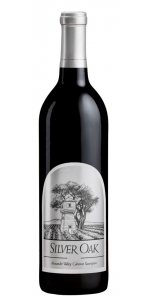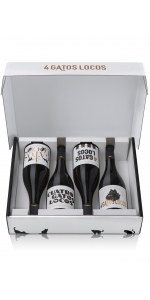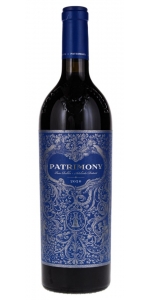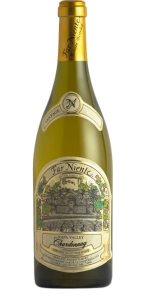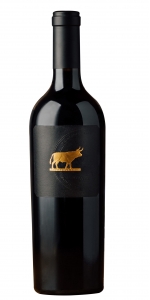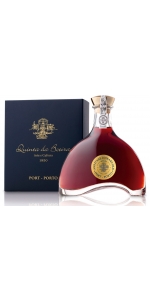CONCHA Y TORO Cabernet Sauvignon Puente Alto Don Melchor 2020
| Country: | Chile |
| Region: | Maipo Valley |
| Winery: | Don Melcho |
| Grape Type: | Cabernet Sauvignon |
| Vintage: | 2020 |
| Bottle Size: | 750 ml |
Marques de Casa Concha Heritage is made from 84% Cabernet Sauvignon, 12% Cabernet Franc, & 4% Petit Verdot.
Deep, dark red in color with lush flavors of cherries, blackcurrants, blackberries, cedar, and a bit of black tar. It shows a tremendous concentration of flavors and a smooth, almost silky texture framed by a firm tannic structure that truly stands out at the beginning of the long finish.
This wine pairs beautifully with grilled, roasted, or braised red meats and game in sauces that have a bit of acidity, with tomato or wine or with herbs such as rosemary, thyme, and bay leaf. A perfect wine for most cheeses.
100% estate grown red blend from renowned Puente Alto terroir. Chile’s most acclaimed DO. Upon arriving at the winery, the grapes are destemmed and crushed for fermentation, which takes place in closed stainless steel tanks with daily pump overs throughout the entire 10-day process. The new wine remains in contact with its skins for approximately 10 days, when it is devatted and malolactic fermentation is allowed to take place naturally.
The wine then underwent 16 months in French oak barrels, 40% first use, 60% second use.
El Mariscal vineyard is 600 meters above sea level and is made up of 52.95 hectares, of which 46.23 correspond to Cabernet Sauvignon, 4.52 to Cabernet Franc and 2.20 to Petit Verdot; and it has a density of 5,500 plants/ha, vines that come from mass selection and are mostly on loam. Meanwhile, Don Melchor vineyard is 650 meters above sea level and is made up of 125.96 hectares, of which 112.67 correspond to Cabernet Sauvignon, 1.28 to Cabernet Franc, 2.45% to Merlot, 1.28 to Petit Verdot and 8.28 to ground in rotation. It has a density of 2,000 to 4,000 plants/ha, and the new one (20%), planted between 2004 and 2017 and with a density of 8,000 plants/ha. The vines come from pre-phylloxera mass selection and are on loam. The vineyards are located in the Puente Alto denomination of origin, on the northern bank of the Maipo River, specifically on the river’s third alluvial terrace, which is one of the oldest and that instills great character and elegance to the wines that come from there. The soils are of alluvial origin, rocky, poor in nutrients, and highly permeable due to the amount of gravel in the subsoil, which enables excellent drainage. The climate is semi-arid Mediterranean with a strong influence of the Andes Mountains. This is the coldest part of the Maipo Valley. Its pronounced daily temperature oscillation of approximately 18ºC extends the grape ripening process, concentrating and intensifying its aromas.
Review:
Black pepper and cherry give way to hints of chocolate after some aeration in the glass. The same notes show on the palate and blend with bell pepper. This red comes from the alluvial soils in the D.O. Puente Alto and is full bodied, with a firm structure. Moderate acidity is enough to freshen up the finish.
-Wine Enthusiast 92 Points
The Peumo Vineyard is located 170 m above sea level and extended along the Cachapoal River, on terraces of hills of the Coastal Mountains. The vines come from pre-phylloxera cuttings and are trellised to vertical shoot position and cordon pruned. The soils are deep with an upper layer of clay that retains moisture, which controls the vines’ vigor and growth and allows them to remain active through late May, when the Carmenere is picked.
Deep, dark red with hints of violet. Elegant and mineral on the nose, with notes of blackberry and a touch of blackcurrant. It fills the palate with underlying mature tannins. Deep, concentrated, with a long aftertaste and distinctive hints of the Peumo terroir. This 2018 vintage is characterized by its elegance and freshness; it is a wine with a lot of Carmenere character. Pairs best with elegant but simply prepared dishes such as juicy, rare roast beef, veal, pork tenderloin with roasted beets and cranberries, duck (con t or magret). Also delightful with squash-stuffed pasta with morel mushrooms or aged goat cheese with figs.
Review:
The 2018 Carménère Carmín de Peumo is made with grapes from 35-year-old vines and painstakingly overseen by Marcio Ramírez, who adds dabs of Cabernet Franc and Cabernet Sauvignon before aging the wine for 15 months in French oak to achieve a new level of complexity. Deep purple in color. The nose offers black tea and cedar aromas combined with blueberry, black currant and white pepper. With juicy, fine-grained tannins, in the mouth it is fleshy and full-flavored, conveying a surprisingly light feel. Sets a high benchmark for Chilean Carménère/.
-Vinous 94 Points
Silver Oak Alexander Valley Cabernet Sauvignon is made from 95.2% Cabernet Sauvignon, 2.5% Cabernet Franc, 1.9% Merlot, 0.4% Petit Verdot
The Silver Oak Alexander Valley Cabernet Sauvignon 2019 has notes of red cherry, raspberry, blackberry, iris, vanilla and clove. Ruby in color, this elegant wine has great acidity and lift on the mid-palate. Black currant and warm baking spices linger with a deep and fruity finish. It will provide drinking pleasure through 2047 given proper cellaring.
Review:
Plush and sexy, Silver Oak’s dazzling 2020 Alexander Valley Cabernet Sauvignon delivers succulent dark fruit offset by black olive-like nuances. Polished and suave tannins provide support without being intrusive or distracting, allowing for immediate enjoyment with a steak. Good acidity keeps it bright and you coming back for another sip.---- Michael Apstein
- Wine Review Online 93 Points
Mason Cellars Pelissa Vineyard Cabernet Sauvignon is made from 100 percent Cabernet Sauvignon.
The 2020 Mason Oakville Cabernet Sauvignon is quintessentially Oakville from nose to finish. Attractive fresh blackberry, red current and chocolate with a hint of sweet oak boast out of the glass. This wine showcases graphite, velvety tannins and concentrated, beautifully balanced flavors with a bit of spice and white pepper. These bold flavors typical of Oakville Cabernet are rounded out with velvety tannins, a weighty mid-palate and a long, juicy finish.
Production Notes:
The fruit was delicately hand-picked in the early morning hours and brought into the winery for processing. The grapes were crushed, about 60% whole berry, and cold soaked for three days before being inoculated for primary and malo-lactic fermentation. Once dry, the wine was put down to barrel for 20 months in medium toast French oak, 25% of which was new.
Vineyard Notes:
Grapes for our 2020 Mason Cabernet Sauvignon are sourced exclusively from the Pelissa Vineyard in Oakville. This vineyard spans 60 acres and is planted to Old BV Clone 7 Cabernet Sauvignon as well as Zinfandel. This vineyard is named for Andrew and Babe Pelissa, who after their marriage on August 30, 1930, made their home at the site of this vineyard which, at the time, was a dairy. Oakville is the core of Napa Valley’s famed Cabernet Sauvignon production, and this site is no exception with the flawless blending of climate and soil to create a remarkable wine.
Review:
“This firmly structured, well-balanced wine has the feel of a classic Bordeaux blend. Just-ripe red and black fruits blend with subtle toast, cedar and mint on a moderately tannic, slightly tangy texture. The wine is tasty enough to decant and drink soon with grilled lamb chops or roast chicken. Best from 2026–2036.” – Jim Gordon
-Wine Enthusiast 94 Points
4 Gatos Locos Cabernet Sauvignon Gualtallary is made from 100% Cabernet Sauvignon.
4 Gatos Locos is a project created by Gabriel Bloise, Facundo Bonamaizon, Mariana and Juan Pelizzatti - winemaker, viticulturist and founders of Chakana Winery (respectively). The project centers on a 20-hectare vineyard in Alto Gualtallary, the most prominent growing region in Argentina. The vineyard is situated 1,360 meters above sea level, on a 10% slope on the Sierra del Jaboncillo - a relatively old geological formation near the alluvial fan of the Las Tunas river, in the Tupungato area. The long exposure to arid conditions of calcium rich gravel has created one of the most calcium carbonate-rich areas in Mendoza. This combination of altitude, slope, gravel and the calcium carbonate create uniquely deep, textured wines, with intense color and mineral freshness. Moderate high temperatures controlled by high altitude in sunny conditions produce perfectly ripe grapes of unusually intense color and great vitality, balanced by the mineral freshness of calcium carbonate. Local aromatic plants, naturally occurring in native vegetation areas interspersed in the vineyard, give the wine a unique herbal touch that underline the character of the place.
Deep purple red colored with intense complex notes of red berries and spice, well integrated aromatic oak and very fine tannins structuring a powerful and elegant palate.
Deep ruby in color, this wine boasts aromas of cassis, blueberry, pomegranate, and currants. Notes of tobacco, chocolate, and toasted spices follow, bringing an immense depth to this wine. The palate is full-bodied and rich with ideal balance between concentrated fruit and freshness. From its mouthwatering acidity and flawlessly integrated oak, it finishes with notes of blackberry jam, cacao, and mocha complemented with herbaceous tones of fennel and thyme.
Review:
The 2020 Cabernet Sauvignon is cut from the same cloth as the 2019, yet is perhaps richer and more expansive, with slightly less elegance. Currants, chocolate, toasted spices, and tobacco all define this beauty, and it has full-bodied richness, flawlessly integrated oak, good acidity, and a great finish. Anyone doubting the quality that can be achieved in Cabernet Sauvignon from Paso Robles owes it to themselves to try one of these wines.
-Jeb Dunnuck 97-99 Points
CONCHA Y TORO Cabernet Sauvignon Puente Alto Don Melchor is made from 92% Cabernet Sauvignon, 6% Cabernet Franc, 1% Merlot, 1% Petit Verdot.
Deep violet in color, intense, and with a great aromatic complexity of red fruits together with floral notes of violets and roses. On the palate, it is a tasty wine with a soft spell and a superb freshness, along with the elegance and power so characteristic of Puente Alto. It is a wine with a velvety texture, lush body, and a very long and persistent finish.
Review:
Deep and serious with black olives, blackberries, blueberries, tobacco leaf, sweet red capsicum, ash, dried meat and a hint of black chocolate. This is a more direct, full-bodied Don Melchor, filled with solid blackberries and wrapped by tight, fine-grained tannins. Long and deep. 92% cabernet sauvignon, 6% cabernet franc, 1% merlot and 1% petit verdot. Better after 2024.
-James Suckling 97 Points
The story of the Don Melchor wine begins in the mid-1980s when the Chilean wine industry was undergoing another transformation and beginning to create very high quality wines. A dream began to take shape at Viña Concha y Toro that would eventually change the future of Chilean wines forever and Peynaud immediately recognized the excellence of the wines from that terroir and suggested that his closest colleague, Jacques Boissenot, consultant for renowned French châteaux, lead the project.
The adventure had already begun two years earlier, when Mr. Eduardo Guilisasti insisted that his son Rafael and winemaker Goetz Von Gersdorff travel to Bordeaux, France to meet with the renowned French maestro Emilie Peynaud, considered the father of modern winemaking. They showed him the Cabernet Sauvignon from the Puente Alto Vineyard.
The 2023 Far Niente Chardonnay enchants with a bouquet of citrus, white floral, and hints of honeydew melon and nectarine. Its silky texture and bright, refreshing palate dance with flavors of lemon/lime zest and lemon verbena, culminating in a long, juicy finish that leaves the palate yearning for more.
Review:
Pure aromas of lemon confit, poached Asian pears, pastry and lanolin. The palate is medium-bodied with focused acidity and a creamy texture, giving notes of lime curd, orange blossoms, yellow apples and flint. Very well constructed and polished.
-James Suckling 93 Points
a Plume du Peintre - "feather of the painter" - wines (Lirac, Chateauneuf-du-Pape and Tavel) are only made in select years representing outstanding quality.
Deep ruby red, opaque. Aromas of red fruits, mocha, touches of leather, black truffles and coffee. Fat, very concentrated and full flavored, with an infinitely long liquoriced and fruity finish.
Pairs well with red meats, sauce dishes, game animals (woodcock, wild boar) and semi mature cheeses.
Review:
"Lastly, and a tiny production cuvée based on 100% Grenache brought up in new barrels, the 2019 Châteauneuf Du Pape La Plume Du Peintre reveals a saturated, almost inky purple color as well as a mammoth-sized bouquet of black currants, bloody meats, lead pencil, tobacco, chocolate, and crushed stone, it nevertheless has notable purity, a full-bodied, layered, seamless texture, no hard edges, and a thrilling finish that offers more and more minerality. with time in the glass. You don't see wines like this often today, but this is a singular, heavenly Grenache that's going to need 4-5 years of bottle age and live for 30-40 years if stored correctly given its concentration, structure, and purity. Hats off to the team at Domaine de la Mordorée for continuing to push the envelope and making incredibly singular wines!”
- Jeb Dunnuck (November 2021), 98+ pts
Irresistible ripened plums and opulent dusty blackberries lift the senses, alluring the nose to tertiary notes of delicate florals and intriguing mineral edges. Balance is the defining quality of this wine; even in its youth, 2021 Black Label is resolutely complete from beginning to end. Every element is in place, as dimpled yet silky tannins unfold with grace and finesse, revealing a core of power and depth. Broad strokes of black mulberries, crème de cassis, and juniper accelerate through the mid-palate with captivating width and focus. This thrilling dance culminates in a stunning finish of opulent and elegant dark fruits that persist with each sip, leaving an indelible impression of the near-perfect growing season that shaped the Fortuna Vineyard—full of power and sinue—and Leopoldina Vineyard—full of poise and intention—in the 2021 vintage.
"Stunning stuff, the 2021 Cabernet Sauvignon Black Label offers a full-bodied, deep, majestic style as well as beautiful aromatics of cr me de cassis, violets, flowers, and nicely integrated background oak. It has ultra-fine tannins, flawless balance, and a regal, age-worthy style that has so much to love. It, however, is not going to be for the instant gratification crowd and this actually shut down pretty quickly with air. I would hide bottle for 4-6 years and it s going to cruise over the following two decades in cold cellars."
- 97 Points Jeb Dunnuck
Castellare di Castellina 'I Sodi di San Niccolo' Toscana IGT is a blend of Sangioveto (85%-90%) and Malvasia nera (15-10%)
Castellare’s top wine, ranked in the Wine Spectator Top 100 on multiple occasions and recognised with the prestigious Gambero Rosso’s Tre Bicchieri and Bidenda’s Cinque Grappoli ratings. The company takes great pride in demonstrating the greatness of the Sangioveto variety, paired with Malvasia Nera, achieving a worldwide position of sixth place.
Pairs well with cold cuts and meat rich in flavour, cheeses with a strong and aromatic taste, in particular, Pecorino Toscano and Parmigiano.
The masterpiece of Castellare, I Sodi di San Niccolo, has twice placed in the top 100 of Wine Spectator, and has been awarded “Three Glasses” by Il Gambero Rosso.
I Sodi di San Niccolo is produced solely with native varieties: 85-90% of Sangioveto and 10-15% of Malvasia Nera, I Sodi comes from the two best crus of the farm.
The word "I Sodi" was used by the Tuscan farmers to describe those grounds which had to be processed by hand, being too hard (in fact firm) or too steep to allow for the employment of the horses, unlike the "fields" that make the grounds more easily cultivable.
Reviews:
Clear ruby with a fine garnet sheen. Impressive nose, very finely drawn, aromas of juicy cherries, blood orange and dried thyme, some liquorice in the background. Polished and precise from the attack to the finish, finely-meshed, very well-integrated tannins, flows beautifully, finely worked out fruit, long finish.
-Falstaff 97 Points
Complex and deeply embedded aromas of ripe blackberries, spices and aromatic bark. Full-bodied and very firm for now, with impressive concentration of fruit and tannin. Very long, balanced finish. Great to taste now, but this is one for the cellar. Patience will be rewarded. Sangiovese and malvasia nera. This has always been a top Tuscan red. Best from 2027.
- James Suckling 96 Points
Super fragranced nose, patchouli, pot pourri, Turkish Delight, rose with caramelised red berries and a touch of smoke and incense - all quiet forward and expressive. The nose alone you could smell for hours such is its complexity and beguiling nature. Powerful and concentrated on the palate, this is broad and muscular, sinewy with depth and determination. Tannins are well integrated, really giving the support to the fruit and acidity, driving the flavours forward despite the clear weight and hold. Fragranced red berries continue on the palate with a touch of stone, graphite and matchstick. Rich and big on the mid palate, becoming more focussed towards the finish. Cleary well made with lots going on. Acidity is great, it's cool, clean, sleek and packed full of flavour. Almost too much, this is a big wine, so needs time, but has lots of appeal and mouthwatering freshness throughout. Released on the 9th March. Director and winemaker Alessandro Cellai.
- Decanter 96 Points
G.D. Vajra Bricco Delle Viole Barolo is made from 100 percent Nebbiolo.
The Barolo Bricco delle Viole shows the signature verticality of its vineyard. The wine is beautifully layered and - while restrained as it’s always the case in the youth of Bricco delle Viole - it also shows a complexity of layers with purple flowers, sweet spices and mineral tones. The palate is noble, with a refined acid spine and profound tannins that promise a long aging potential.
Among the historical vineyards of Barolo, Bricco delle Viole is the highest and the closest to the Alps. It rises from 400 to 480 meters above sea level, on the Western ridge of the village. Its name, “Hill of Violets”, originates from the flowers that blossom early here due to the perfect south exposure. Up above the fogs, Bricco delle Viole enjoys the earliest sunrise and the last sunset every day. Thanks to its vines dating back to 1949 and -now- 1931, a dramatic diuturnal temperature range and this pure light, Bricco delle Viole generates a sophisticated and profound Barolo DOCG of bright aromatics, chiseled tannins and subtle minerality. 2018 is a vintage that shows many nuances of Bricco delle Viole: beyond the signature verticality of this site, the wine offers high tones laced with mineral nuances and plenty of energy and youth.
Review:
A juicy Barolo, with vibrant acidity and a fluid profile that exudes cherry, raspberry, mown hay, mineral and eucalyptus aromas and flavors. Tight yet long, with excellent potential.
#26 Wine Spectator Top 100 of 2023
The last wine poured at my tasting at the winery is the G.D. Vajra 2019 Barolo Bricco delle Viole. With its high vantage point in the hills west of Barolo, Bricco delle Viole is a world apart in terms of soils (with Sant'Agata marl and fossils) and even harvest times. Slow and careful ripening like the kind that characterizes fruit in 2019 renders a very delicate and ethereal expression with floral tones, wild mint and licorice. This organic wine is solid in build and structure. Indeed, Isidoro Vaira remarks that Nebbiolo tannins have changed since the 1970s and 1980s.
-Wine Advocate 97+ Points
Jeweled in appearance, the 2019 Barolo Bricco Delle Viole may be the best wine I have tried yet from Vajra. Its gorgeous and alluring perfume of fresh roses is followed by a Burgundian, elegant red with incredible length and no harsh edges, fine and present tannins, and beautiful, graceful concentration. It is drinking well now, and I will be trying to get my hands on as much of this as possible. Drink 2025-2045.
-Jeb Dunnuck 97 Points
Boeira Tawny 20 Year Port is made from 40% Touriga Nacional, 30% Touriga Francesa and 30% Tinta Roriz.
A Good Complexity of Natural Flavors of Cassis, Blackberries and Caramel.
Fermentation in steel tank and stopped by adding spirit and aged in oak barrels for 20 years. Wine was slightly filtered before bottling.
Review:
The NV 20 Year Port is based on Touriga Nacional, Touriga Franca, Tinta Roriz, Tinta Barroca, and Tinto Cão and was aged 20 years in French oak casks. It's more complex and nuanced, with beautiful white raisin, white chocolate, ripe cherries, caramelized fig, and smoky tobacco nuances. Beautifully balanced and medium to full-bodied, it has a layered mouthfeel, a ripe tannic structure, and one heck of a great finish.
-Jeb Dunnuck 94 Points
- back
The Gigondas appellation is naturally delimited by the Dentelles de Montmirail to the east and the upper plateaux of the Ouvèze River to the west. The rugged topography of the Dentelles, amazing limestone pyramids, protects the vines from excessive summer heat and the full force of the mistral. Our vines grow on steep terraces up to 400 metres in altitude.
This Cru Gigondas displays a fine balance between freshness and an impression of sweetness due to old Grenache vines planted at high altitude. The wine is big on the palate, with a dense texture of rich, ripe tannin. Its polished personality reflects a top-rate terroir.
Review:
"Very full, rich and luxurious in style with ripe red berries and some rich, meaty fruit coming through on the palate; grainy and gritty tannins, with plenty to chew on. Feels youthful and tight but harmonious. The lovely acid line brings precision and pep. Tapered finish. Very appealing!"
- Decanter WWA 2022, 96 points and Gold Medal
GRAPE
100% Arneis
POSITION
Hillside
EXPOSURE
Southwest
COLOR
Straw yellow with greenish reflections
NOSE
The bouquet is fruity with hints of chamomile and acacia
TASTE
Fresh elegant, fruity aromas with floral hints
TEMPERATURE
Ideal serving temperature is 8°/10°C.
ALCOHOL
12.5 % - 13%




